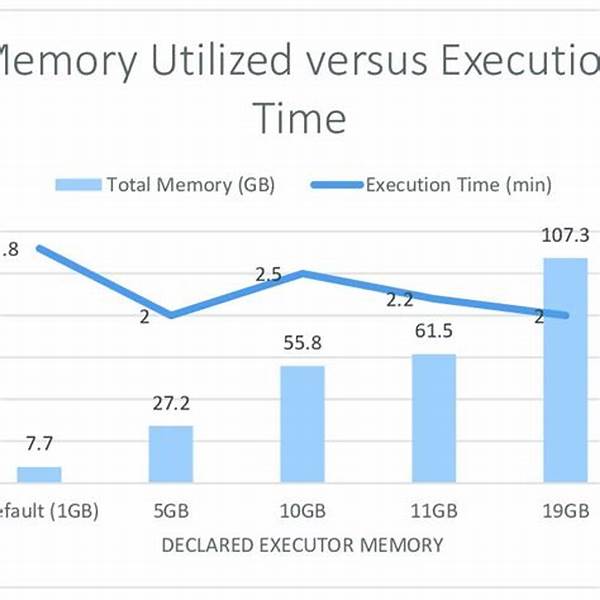Hey there, fellow tech enthusiasts! Today, let’s dive into the intriguing world of “Memory Usage Versus Execution Speed.” It’s like when you’re trying to find the perfect balance between chugging a coffee for a quick energy boost or sipping it slowly to savor every drop. In the tech realm, we’re constantly juggling between making our code run faster and ensuring it doesn’t gobble up all the memory available. So, grab your favorite snack, and let’s explore this fascinating topic together!
Read Now : Overcoming Visual Scripting Learning Hurdles
The Balancing Act: Memory Usage Versus Execution Speed
Ah, the eternal question: should we prioritize speed or memory efficiency in our software projects? The reality is that both are crucial, and striking the right balance can make all the difference. If you’re working on a gaming app, for example, execution speed might take precedence to provide users with a seamless experience. On the other hand, if you’re developing an application for devices with limited resources, conserving memory usage becomes vital. This balancing act can often feel like a tightrope walk, and understanding the nuances of memory usage versus execution speed is key to achieving the optimal performance characteristics for your application.
When considering memory usage versus execution speed, it’s important to understand how they impact user experience and system performance. Sometimes, faster code leads to greater memory consumption, which might not be ideal in environments with limited resources. Conversely, minimizing memory usage might slow down execution, causing delays that frustrate users. Developers often have to make trade-offs and adjustments according to the specific needs and constraints of their projects. This ongoing challenge keeps the coding world buzzing with innovative solutions and approaches, each tailored to solve this timeless dilemma in unique ways.
Quick Insights Into Memory Usage Versus Execution Speed
1. Memory Efficiency for Old Devices: If your application targets older devices, minimizing memory usage is key. You might need to accept slower execution speeds to keep memory consumption in check.
2. High-Speed Gaming Apps: For game developers, execution speed is often prioritized. Fast performance ensures players enjoy a seamless gaming experience, even if memory usage increases.
3. Web Apps Hangups: Often, web applications face limits on memory usage due to browser restrictions. Devs strive to maintain a balance without sacrificing execution speed.
4. Data-Intensive Tasks: In data-heavy applications, quick execution is crucial, but it demands high memory usage. The challenge is in efficient memory management.
5. The Cloud Advantage: Cloud applications can afford higher memory usage since the infrastructure can handle efficient resource scaling, allowing faster code execution.
Technical Considerations in Memory Usage Versus Execution Speed
In the world of software development, there are several factors to ponder when optimizing memory usage versus execution speed. Variables like data types, algorithm choices, and data structures play significant roles in influencing these aspects. Choosing efficient algorithms can lead to faster execution but may require trade-offs in memory utilization. On the contrary, some data structures might save memory but slow down processing times. It’s a constant balancing act, where developers must weigh the pros and cons of different approaches to achieve desired results.
Another critical consideration is the hardware environment where the application will run. Applications meant for high-performance machines can afford more relaxed constraints on memory usage, whereas apps for low-powered devices must be more conservative. Developers often make these decisions based on the specific goals and constraints of their projects. Understanding the hardware efficiency and aligning it with software requirements is vital in addressing the memory usage versus execution speed puzzle, making the software development journey both exciting and challenging.
Practical Tips to Balance Memory Usage Versus Execution Speed
1. Use Efficient Data Structures: Choose data structures that offer optimal memory usage and execution speed balance, such as hash tables or binary trees, based on your requirements.
2. Optimize Code Carefully: Revise and refactor code to remove inefficiencies and enhance performance, leading to improved execution speed without dramatically increasing memory usage.
3. Profiling Tools: Utilize tools to profile both memory usage and execution speed, identifying bottlenecks and areas for improvement.
4. Consider Language Choice: Different programming languages offer varied efficiency. For instance, C++ might provide better control over memory usage versus execution speed compared to Python.
Read Now : Computational Physics For Games
5. Leverage Concurrency: Parallel processing can enhance execution speed but may increase memory usage, demanding careful balancing during implementation.
6. Garbage Collection: Understanding how and when memory is released during execution helps manage memory usage more effectively.
7. Memory Allocation: Adjust memory allocation strategies for different parts of your application to optimize both speed and usage.
8. Analyze Access Patterns: Consider how data access patterns affect memory use and speed; oftentimes, redesigning data flow can yield significant improvements.
9. Keep It Simple: Reducing program complexity can naturally balance memory usage and speed, making management efficient.
10. Regular Updates: Continually optimize and update applications to adjust to new technologies and methodologies, improving memory usage versus execution speed.
Challenges in Memory Usage Versus Execution Speed
Let’s face it, finding the perfect balance between memory usage and execution speed is like searching for the holy grail in software development. You have to deal with challenges that crop up at every corner. Whether you’re trying to fit complex data structures into limited memory or experimenting with faster algorithms that hog CPU power, the struggle is real. Memory usage versus execution speed is a puzzle that remains tough to crack, demanding clever solutions, compromise, and a willingness to revisit and refine code. Developers often rely on profiling tools and performance metrics to pinpoint and address issues, making ongoing optimization a perpetual part of the coding journey.
One notable challenge comes with scalability. As applications evolve, what worked in the prototype phase may not hold up when scaled to production-level traffic. This scalability challenge makes the choices around memory usage versus execution speed even more critical. For growing applications, developers must not only optimize current performance but also plan for future demands. Balancing resource efficiency, especially in cloud environments, requires a nuanced approach that anticipates growth while managing the present effectively.
Conclusion on Memory Usage Versus Execution Speed
To wrap it all up, navigating the labyrinth of memory usage versus execution speed is no small feat. Developers are constantly seeking that sweet spot where applications run efficiently without devouring all available resources. The journey often involves experimenting, learning from failures, and iterating on solutions to achieve the right balance for each unique project. It’s like being a tightrope walker, carefully stepping to maintain equilibrium while moving forward.
In the end, the art of balancing memory usage versus execution speed is central to crafting successful, performant applications. By understanding the trade-offs and adjusting strategies to match specific needs, developers can create software that excels in functionality and user experience. This never-ending story of trial and adaptation is what makes software development both challenging and rewarding. Whether you’re a seasoned pro or just starting, the journey of exploring and resolving these issues is an adventure worth embarking upon. So, keep coding and optimizing, because the world of technology never stands still!




